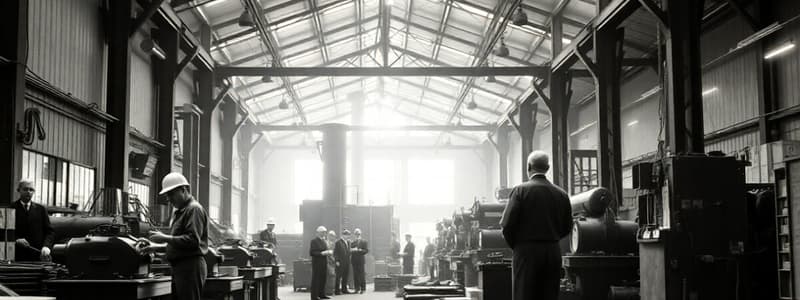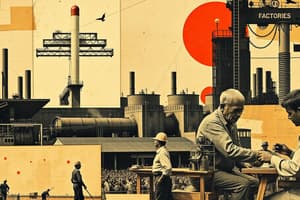Podcast
Questions and Answers
What year was the Factory Act originally enacted?
What year was the Factory Act originally enacted?
1881
Which of the following years did not see an amendment to the Factory Act?
Which of the following years did not see an amendment to the Factory Act?
- 1891
- 1948
- 1988 (correct)
- 1976
The Factory Act 1948 is less comprehensive than its predecessors.
The Factory Act 1948 is less comprehensive than its predecessors.
False (B)
What was a significant industrial disaster that raised awareness of pollution and factory hazards?
What was a significant industrial disaster that raised awareness of pollution and factory hazards?
The minimum age to work in factories according to the Factory Act 1948 is _____ years.
The minimum age to work in factories according to the Factory Act 1948 is _____ years.
What is the minimum number of workers for the Factory Act to apply if power is used?
What is the minimum number of workers for the Factory Act to apply if power is used?
Industry and factory refer to the same concept.
Industry and factory refer to the same concept.
The weekly working hours according to the Factory Act for adults is limited to _____ hours.
The weekly working hours according to the Factory Act for adults is limited to _____ hours.
In which year was the first Iron and Steel work started in India?
In which year was the first Iron and Steel work started in India?
When did the Factory Act come into existence?
When did the Factory Act come into existence?
Which of the following years did the Factory Act undergo extensive amendments?
Which of the following years did the Factory Act undergo extensive amendments?
The Factory Act of 1948 is less comprehensive than the previous acts.
The Factory Act of 1948 is less comprehensive than the previous acts.
What is the required minimum age to work in factories according to the Factory Act?
What is the required minimum age to work in factories according to the Factory Act?
What significant event in 1984 raised awareness about pollution and factory hazards?
What significant event in 1984 raised awareness about pollution and factory hazards?
Which provisions are included in the Factory Act?
Which provisions are included in the Factory Act?
The Factory Act is applicable to all factories employing ____ persons or more when using power.
The Factory Act is applicable to all factories employing ____ persons or more when using power.
The first cotton textile factory in India was set up in ____ as early as 1854.
The first cotton textile factory in India was set up in ____ as early as 1854.
Industry and factory are the same in modern terms.
Industry and factory are the same in modern terms.
Flashcards are hidden until you start studying
Study Notes
Historical Background of the Factories Act 1948
- The Factory Act originated in India in 1881, aiming to regulate working conditions.
- This Act covers health, safety, working conditions, and hazardous processes for workers, It also establishes penalties for violations.
- Multiple amendments were made to the Act throughout its history, with the most extensive revision occurring in 1948.
- The 1948 Act focused on the well-being of workers, including health, safety, welfare, working hours, minimum work age, and paid leave.
- It was inspired by the 1937 Factory Act of Great Britain.
- The Bhopal Gas Tragedy in 1984 highlighted the severe consequences of factory pollution and hazards, leading to renewed calls for amendments and stricter regulations.
- The Act applies to factories with 10 or more employees using power or 20 or more employees without using power.
- Key provisions include safety measures, guarding machines, health and cleanliness standards, drinking water, washing facilities, lunch rooms, rest rooms, sitting arrangements, first aid and dispensaries (in factories with over 500 workers), creches (where over 50 women are employed), welfare officers (for factories with over 500 workers), spittoons, paid holidays, weekly working hours (max 48 for adults, 27 for younger persons), regulations for young workers, overtime pay, mandatory rest breaks, working hour limits, and a weekly holiday.
- The need for amendments arose due to advancements in safety and health practices, and the influence of ILO conventions.
Evolution of Factories in India
- The first cotton textile factory in India was established in Bombay in 1854.
- The growth of factories accelerated by 1870, with significant establishments in Bombay, Nagpur, Kanpur, and Madras.
- The first Iron & Steelwork opened in Bihar in 1873, and jute spinning mills were established in Rishra in 1855.
- Bengal had 5,000 power looms in operation by 1881, while the Bally Paper mills were set up in Hoogly in 1870.
- Several tanneries and leather factories also emerged in Kanpur, contributing to the rise of factory employment in India.
Early Labor Conditions and Reform Calls
- The rapid industrialization led to concerns about worker exploitation, including the employment of women and children at young ages, excessive working hours, hazardous and unsanitary conditions.
- While calls for protective labor laws emerged as early as 1850, the British government took little action despite existing factory legislation in Great Britain at the time.
- Social reformers, including Sorabjee Shahpurjee Bengali, raised concerns about the plight of workers.
- Sasipad Bannerjee established the Bara Bazar organization in 1878 to advocate for the welfare of jute mill workers.
Historical Background of the Factories Act 1948
- The Factories Act is a central legislation in India, first enacted in 1881, regulating working conditions in factories.
- It focuses on health, safety, working hours, minimum age, leave with pay, and other aspects of workers' lives.
- The Act has undergone numerous amendments, most notably in 1948, which expanded its scope and took inspiration from the 1937 Factory Act in Britain.
Key Provisions
- The Act applies to factories using power and employing 10 or more workers.
- In factories without power, the threshold is 20 workers.
- Main provisions include:
- Safety measures: Guarding machinery, maintaining clean and healthy environments.
- Basic facilities: Providing drinking water, washing and latrine facilities, lunch rooms, rest rooms.
- Welfare facilities: First aid and dispensary for factories employing more than 500 workers, creches for workplaces with over 50 women, and welfare officers for factories with over 500 workers.
- Other provisions: Stipulating working hours, providing rest periods, regulating overtime work, and ensuring weekly holidays with pay based on days worked.
Early Industrial Development and Emergence of Factory Legislation
- India's industrialization began in the mid-19th century.
- The first cotton textile factory was established in Bombay in 1854.
- The growth of factories in various industries led to significant employment and a need for protective regulations.
Early Concerns about Worker Welfare
- The rapid industrialization exposed workers to hazardous conditions and long hours.
- The lack of regulations and poor working conditions, including the exploitation of women and children, led to a growing demand for better working conditions.
- These issues were addressed by philanthropists like Sorabjee Shahpurjee Bengali and activists like Sasipad Bannerjee, who advocated for worker welfare.
- While concerns for worker welfare were raised as early as 1850, it was not until 1881 that the first Factories Act was introduced in India.
Studying That Suits You
Use AI to generate personalized quizzes and flashcards to suit your learning preferences.




